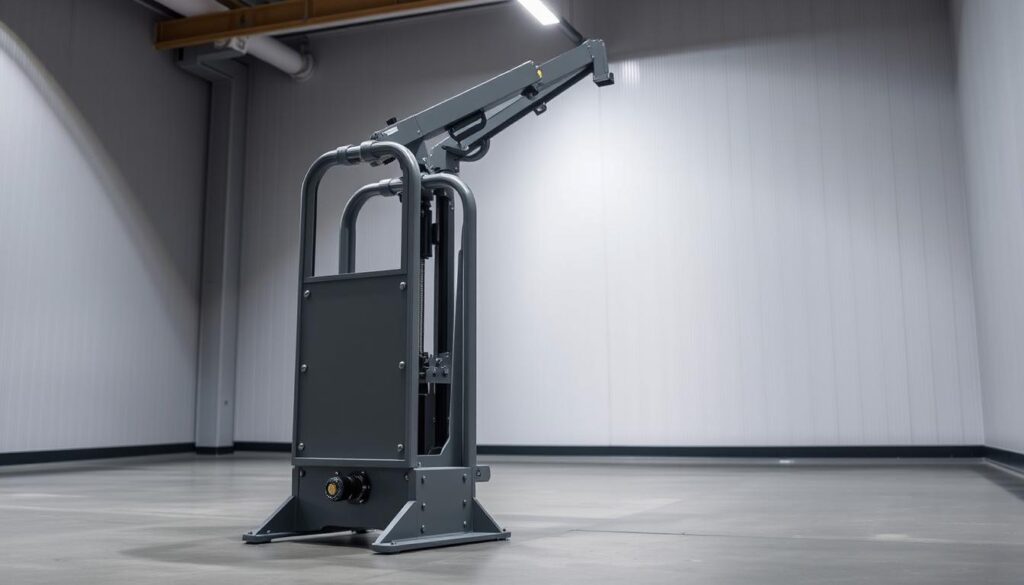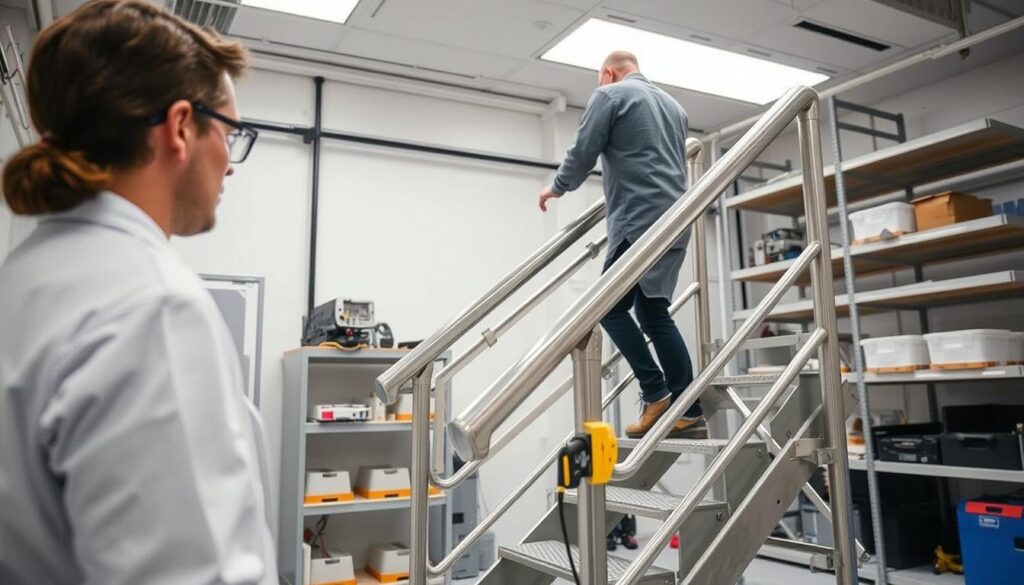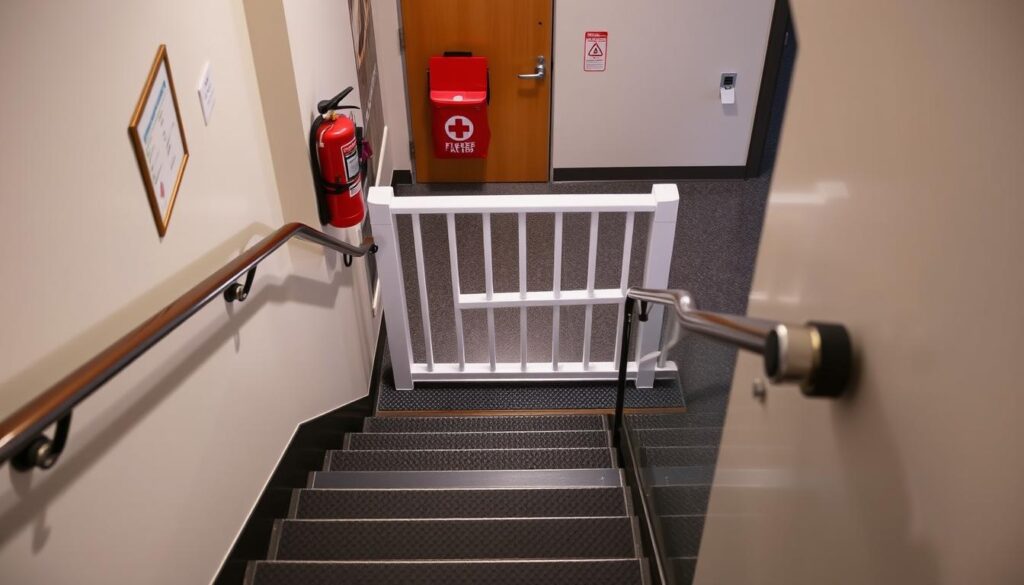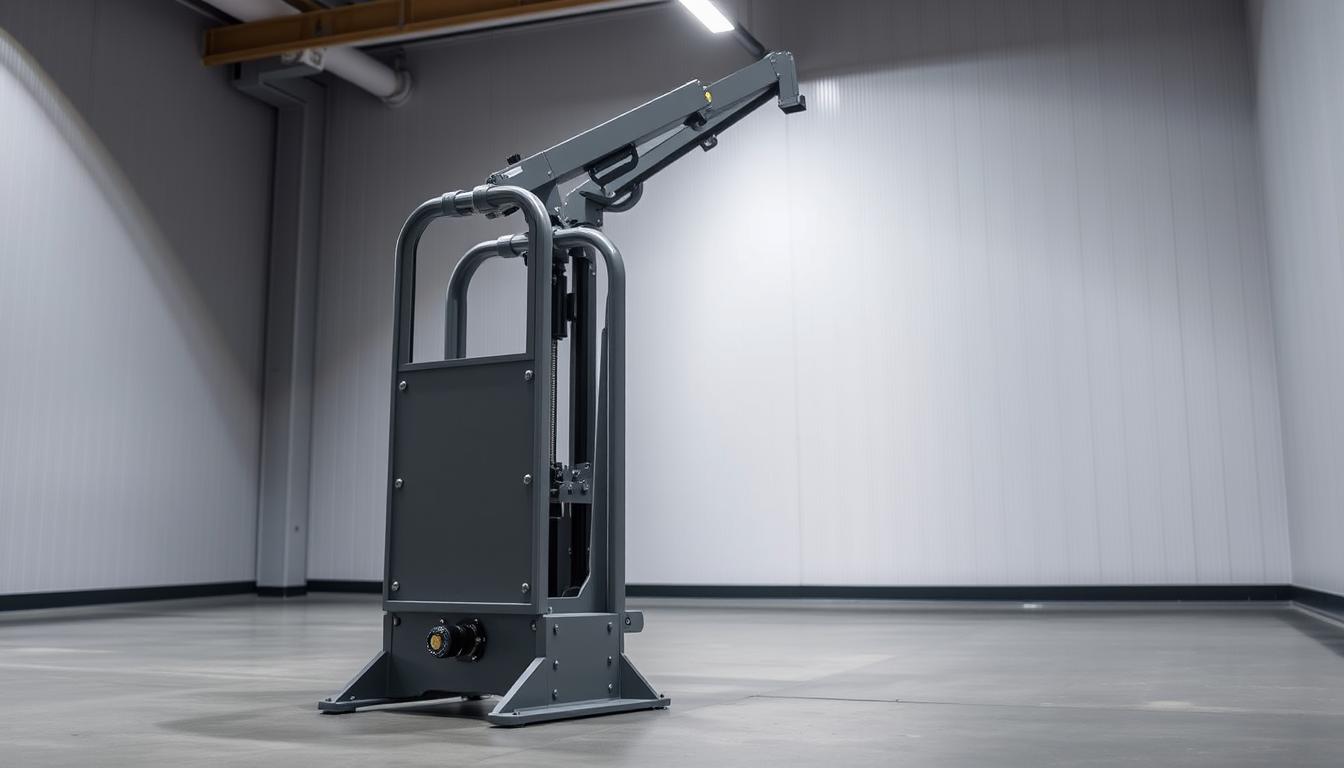A stair pusher is key for keeping your facility safe. It helps find and fix safety risks before they cause harm. This tool is vital for keeping everyone safe.

Testing stairs often is a must to avoid accidents. A stair pusher helps spot dangers and fix them. It makes sure your stairs meet safety standards.
Key Takeaways Stair Pusher for Safety Testing
- Stair pusher for safety testing is essential for facility safety
- Stair safety equipment helps identify potential hazards
- Stair testing devices provide accurate results and ensure compliance
- Regular safety testing prevents stair-related accidents
- Stair safety equipment is crucial for maintaining a safe environment
- Facilities can use stair testing devices to ensure compliance with safety regulations
Understanding the Importance of Stair Safety Testing
Stair safety is key in facility safety testing. It helps prevent accidents and follows stair safety rules. Regular tests find hazards and fix them before they cause problems. In buildings, stairs can be dangerous due to bad maintenance, poor lighting, and not following safety rules.
Accidents on stairs often happen because of slippery surfaces, uneven steps, and inadequate handrails. To lower these risks, it’s important for facilities to focus on stair safety. They should check stairs often and fix any issues they find.
By making stair safety a priority, facilities can lower accident risks. They also make sure they follow safety rules and avoid legal problems. Regular checks help find ways to make stairs safer, preventing accidents before they happen.
What Is a Stair Pusher for Safety Testing?
A stair pusher is a key tool in safety tests. It makes sure staircases are safe and stable in buildings. It pushes on the stairs to test their strength, like how people use them.
This helps find and fix safety problems early. It lowers the chance of accidents and legal issues.
There are many types of stair pushers for different tests. They have features like adjustable force and digital screens. These help users set up tests, track results, and keep safety records.
Choosing the right stair pusher is important. It depends on the stairs, how much weight it can handle, and how accurate it needs to be. The right one helps meet safety rules, saves money on repairs, and keeps people safe.
Using a stair pusher has many benefits. It finds safety risks and helps plan maintenance. This lowers the risk of accidents and saves money. It shows a building’s dedication to safety for everyone.
Key Features of Modern Stair Testing Equipment
Ensuring stair safety is key, and the right tools are essential. Modern stair testing devices have features that help keep stairs safe and accurate. They offer digital measurements for precise calculations and recordings.
Using modern stair testing equipment brings many benefits. These include:
- Improved accuracy and reliability
- Enhanced data recording functions, allowing for easier tracking and analysis of results
- Calibration options, ensuring that the equipment remains accurate and reliable over time
These devices help facilities meet stair safety standards. They also make regular maintenance easier. This is because they provide accurate results quickly, helping spot any issues fast.
Investing in modern stair testing equipment is crucial. It ensures stair safety and a healthy environment. Facilities can provide a safe space for users and meet regulations by using these devices.
Benefits of Implementing Regular Stair Safety Assessments
Regular stair safety checks are key to spotting dangers and cutting down accident risks. By using stair safety equipment, places can follow rules and make their space safer. Facility safety testing is vital for a safe and healthy place.
Some main benefits of regular stair safety checks are:
- Spotting dangers and fixing them to lower risks
- Lowering the chance of accidents and injuries
- Following rules and avoiding legal troubles
- Making a safer and healthier space for people
By getting stair safety equipment and doing regular facility safety testing, places show they care about safety. This cuts down accident risks and boosts the place’s image.
Regular stair safety checks are a big part of a good safety plan. By focusing on stair safety equipment and facility safety testing, places can make a safer spot for everyone.
How to Choose the Right Stair Pusher for Safety Testing
Choosing the right stair pusher equipment is crucial for your facility. You want to meet stair safety regulations and ensure safety testing protocols are followed. Consider your facility’s specific needs, like the type of stairs and foot traffic.
Here are key factors to think about:
- Size and portability: The equipment should be easy to move and store. It shouldn’t lose accuracy or effectiveness.
- Accuracy requirements: It must give precise results. This aligns with your safety rules and testing.
- Budget planning: The cost should match the benefits. Remember, not having the right equipment can be risky.
By focusing on these points, you can pick the best stair pusher equipment. This ensures your facility follows safety rules and tests are effective. It helps prevent accidents and gives everyone peace of mind.
Setting Up Your Testing Protocol
To ensure stair safety standards are met, it’s crucial to set up a thorough testing protocol. This involves preparing the necessary stair testing devices and following a step-by-step process to guarantee accurate results. When establishing your testing protocol, consider the following key elements:
A well-structured testing protocol should include regular inspections, maintenance, and calibration of stair testing devices to ensure they are functioning correctly. This helps maintain stair safety compliance and reduces the risk of accidents. By following a standardized testing protocol, you can ensure that your stairs meet the required stair safety standards, providing a safe environment for users.
Here’s a simple, structured approach to setting up your testing protocol:
- Prepare the necessary stair testing devices and equipment.
- Conduct regular inspections to identify potential hazards.
- Perform maintenance and calibration tasks as required.
- Record and analyze test results to ensure stair safety compliance.
By following this structured approach and using the right stair testing devices, you can ensure that your stairs meet the required stair safety standards. This provides a safe environment for users and minimizes the risk of accidents.

Compliance Standards and Regulations
Stair safety testing is key to following rules and keeping places safe. Stair safety regulations and stair safety standards help make sure buildings are safe for everyone. In the U.S., the Occupational Safety and Health Administration (OSHA) has rules for facility safety testing, including stairs.
Places must follow OSHA rules, industry standards, and global safety codes. Here are some important ones:
- OSHA rules for stair safety testing, like how often and how to do it
- Standards from the American National Standards Institute (ANSI) for specific industries
- Rules from the International Code Council (ICC) for global safety
Following these rules makes sure stairs are safe and meet stair safety standards. Regular facility safety testing, like checking stairs, finds dangers and stops accidents. Also, following stair safety regulations can prevent fines, Stair Pusher for Safety Testing
To meet stair safety regulations and stair safety standards, places should have a safety testing plan. This plan should include stair checks and other safety tests.
Maintenance and Calibration Guidelines
Regular stair safety maintenance is key to keeping stair testing devices accurate and reliable. It’s important to check the equipment for damage and wear. Also, routine calibrations are needed to get precise results. Following these steps helps prevent accidents and keeps safety standards high, Stair Pusher for Safety Testing
To keep stair pusher equipment in top shape, always follow the maker’s advice. This means cleaning it often, updating software, and running diagnostic tests. Also, setting up a regular maintenance plan is a good idea. This ensures the equipment works well all the time.
- Regularly inspecting the equipment for damage or wear and tear
- Performing routine calibrations to ensure precise results
- Following the manufacturer’s instructions and recommendations
- Implementing a regular maintenance schedule
By focusing on stair safety maintenance and sticking to these tips, places can avoid accidents. They also meet safety rules and make sure their stair testing devices and stair pusher equipment work right.
Training Your Staff for Safety Testing
It’s crucial to train your staff well. They need to know how to use safety testing protocols and Stair Pusher for Safety Testing right. This helps keep your facility safe. They should understand the basics of facility safety testing and spot hazards.
Investing in training can prevent accidents and meet legal standards. A good training plan should mix theory and practice. This includes classroom lessons, hands-on training, and drills for emergencies.
Some important topics to cover are:
- Basic operation procedures for Stair Pusher for Safety Testing
- Documentation needs for safety testing and incident reports
- Emergency steps for accidents or equipment failures
Teaching your staff to use safety testing protocols well makes your workplace safer and more efficient. This lowers the chance of accidents and boosts facility safety testing results. Always update your training to keep it current and useful.

Analyzing and Interpreting Test Results
To ensure stair safety compliance, it’s key to understand test results from stair testing devices. This means looking at the data, spotting hazards, and suggesting fixes. The aim is to keep stair safety standards high and avoid accidents.
When checking test results, follow these steps:
- Look at the data from stair testing devices for trends or patterns.
- Compare the findings to stair safety standards to see if stairs meet them.
- Find hazards like uneven steps or loose handrails and suggest fixes.
By doing these steps and using stair testing devices for stair safety compliance, places can stay safe. Regular checks and analysis are key to keeping stair safety standards up and preventing injuries.
Remember, stair safety compliance is a continuous effort. It needs regular testing and analysis to keep people safe. By focusing on stair safety standards and using stair testing devices, places can make a safer space for all.
Cost-Benefit Analysis of Stair Pusher for Safety Testing Programs
Implementing stair safety equipment and testing is crucial. It may seem expensive at first, but it saves money and reduces risks in the long run.
The cost of stair safety gear is high, but it’s worth it. It helps avoid accidents and injuries. Regular safety checks and stair pusher equipment lower the risk of falls.
Stair Pusher for Safety Testing programs offer many benefits. They include:
- Reduced risk of accidents and injuries
- Minimized costs associated with accidents and injuries
- Improved compliance with safety regulations
- Enhanced reputation and credibility
Stair Pusher for Safety Testing programs save money over time. They cut down on workers’ compensation claims, medical bills, and lost work hours. They also make stairs last longer and save on maintenance.
In conclusion, Stair Pusher for Safety Testing programs are a smart investment. They make places safer and more secure. They also save money and offer many benefits.
Conclusion Stair Pusher for Safety Testing
The stair pusher for safety testing is key for keeping your facility safe. It helps you check your stairs often. This way, you can fix problems before they cause harm, Stair Pusher for Safety Testing
Using stair safety equipment helps you meet legal standards. It also lowers the chance of accidents. This is good for your business and everyone who visits.
Starting a facility safety testing program is smart. It shows you care about safety. It also helps you avoid big problems and keeps everyone safe.
Look for the stair pusher that works best for you. The right tool and a focus on safety make your Stair Pusher for Safety Testing safe for a long time.
FAQ
What is a stair pusher and how does it help with safety testing?
A stair pusher is a tool for testing stairs in buildings. It finds hazards and checks if stairs are strong. This helps prevent accidents and follows safety rules, Stair Pusher for Safety Testing
Why is regular stair safety testing important for facilities?
Testing stairs often helps find and fix dangers. It lowers the chance of accidents and meets legal needs. It also keeps people safe and protects the building.
What are the key features of modern stair testing equipment?
Today’s stair testers, like stair pushers, have digital tools and record data. They also calibrate well. These features make sure tests are accurate and trustworthy.
How can I choose the right stair pusher equipment for my facility?
When picking a stair pusher, think about size, how accurate it needs to be, and your budget. Choose one that fits your building’s needs and follows safety rules.
What are the compliance standards and regulations related to stair safety testing?
Stair tests must follow OSHA rules, industry standards, and global safety codes. Following these rules keeps everyone safe and avoids legal trouble.
How do I properly maintain and calibrate stair pusher equipment?
Keeping stair pushers in good shape is key for good tests. Follow the maker’s advice and set up a regular check-up plan. This keeps the equipment working well.
How do I train my staff to conduct effective stair safety testing?
Teaching your team how to test stairs right is crucial. They need to know how to use it, document results, and handle emergencies. This ensures safe and complete tests.
How do I analyze and interpret the results of stair safety tests?
Understanding test results means looking at the data, spotting dangers, and suggesting fixes. This helps you make smart choices to keep everyone safe.
What are the cost-benefit considerations of implementing a stair safety program?
Starting a stair safety program, with tools like stair pushers, can save money in the long run. It lowers accident risks and legal worries. Weigh the upfront cost against the long-term savings and safety gains.
Source link
- https://www.nachi.org/inspecting-stair-stringers.htm
- https://www.banksindustrial.com/blog/stair-safety-requirements-ibc-versus-osha
- https://ccpia.org/inspecting-stairways-railings-and-guards-at-commercial-buildings/
- https://stairways.org/stair-safety/
- https://georgeintl.com/what-should-you-inspect-stairs-for/
